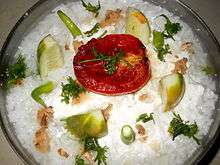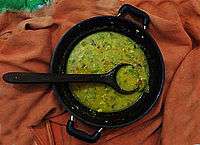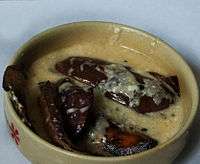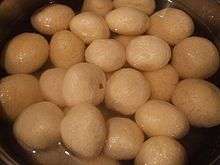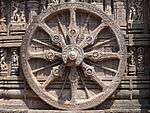Cuisine of Odisha
| This article is part of a series on |
| Odisha |
|---|
 |
| Governance |
|
| Topics |
| GI Products |
|
Districts Divisions |
|
|
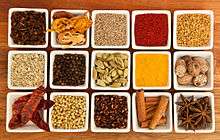 |
| This article is part of the series |
| Indian cuisine |
|---|
|
Regional cuisines
|
|
Ingredients, types of food |
|
See also
|
|
Compared to other regional Indian cuisines, Odia cuisine (Odia: ଓଡ଼ିଆ ଖାଦ୍ୟ) uses less oil and is less spicy while nonetheless remaining flavourful.[1][2] Rice is the staple food of this region. Mustard oil is used in some dishes as the cooking medium, but ghee(made up of cow milk) is preferred in temples.[2] In old times food was traditionally served on banana leaves or disposable plates made of sal leaves.[3]
Odia cooks, particularly from the Puri region, were much sought after due to their ability to cook food in accordance with Hindu scriptures. During the 19th century, many Odia cooks were employed in Bengal and they took many Odia dishes with them.[4] This period also saw a heavy demand for Brahmin cooks, leading many Odia cooks to fake their castes.[5]
Yoghurt is used in dishes. Many sweets of the region are based on chhena (cheese).[6]
Ingredients and seasoning
The ingredients used in Odia cuisine are plantains, jackfruit, and papaya. The curries are garnished with dried raw mango (ambula) .[7]
Panch phutana is a blend of five spices that is widely used in Odia cuisine. It contains mustard, cumin, fenugreek, aniseed and kalonji. Garlic, onion and ginger are used in most of the food. Temple food preparation doesn't allow the use of garlic or onion. Turmeric and red chillies are used regularly[2]
Local variation
The food in the region around Puri-Cuttack is greatly influenced by the Jagannath Temple. On the other hand, kalonji and mustard paste are used mostly in the region bordering Bengal and curries tend to be sweeter. In the region closer to Andhra Pradesh, curry tree leaves and tamarind are used more.[2] The Brahmapur region has influences of South Indian cuisine and the Telugu people living there have invented new Odia dishes.[8]
Temple food
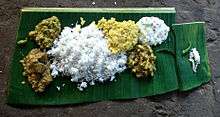
Temples in region make offerings to the presiding deities. The prasada of the Jagannath Temple is well known and is specifically called Maha Prasad meaning greatest of all prasadas. It consists of 56 recipes, so it is called chhapan bhoga. It is based on the legend that Krishna missed his eight meals for seven days while trying to save a village from a storm holding up the Govardhan hill as a shelter.[6]
Fish and seafood
Fish and other seafoods are eaten mainly in coastal areas. Several curries are prepared from prawn and lobster with spices.[2][9] Freshwater fish is available from rivers and irrigation canals.[4] Rohu, Catla and Ilishi are the famous freshwater fishes used in curries.
List of dishes
Rice dishes and rotis
- Pakhala is a rice dish made by adding water to cooked rice. It may then be allowed to ferment overnight. This is called basi pakhala. The unfermented version of this is called saja pakhala. It is served with green chillies, onions, yoghurt, badi etc. It is primarily eaten in summer.[10][11]
- Khechidi is a rice dish cooked with lentils.[12][13] It is the Odia version of khichdi.[14]
- Palau is a rice dish made from vegetables and raisins. It is the Odia version of pilaf.[15][16]
- Kanika is a sweet rice dish, garnished with raisins and nuts.[11][17]
- Ghee rice is fried with ghee and cinnamon
Dal
- Dalma: A dish made from dal and vegetables.[18] It is generally made from toor dal and contains chopped vegetables like green papaya, unripe banana, eggplant, pumpkin, gourd, etc. It is garnished with turmeric, mustard seeds, and panch phutana. There are several variations of this dish.[4]
- Dali : A dish made from one of the Dals like tur, chana, masur, mung or a combination of these.
Curries
Odia cooking has some different type of curries based on the overall preparation style. Tarakari, Santula, Rai, Rasa.
- Santula: A dish of finely chopped vegetables which are sauteed with garlic, green chilies, mustard and spices. It has several variations.[4][11]
- Chaatu rai: A dish made from mushrooms and mustard.[18]
- Alu potala rosa: Curry made from potato and parval.[12]
- Kadali manja rai: A curry made from banana plant stem and mustard seeds. Manja refers to the stem which can be used in dalma.[11][19][20]
- Mahura
- Besara: Assorted vegetables in mustard paste tempered with panch phutana
Khattas and chutneys
Khatta refers to a type of sour side dish or chutney usually served with Odia thalis.[21]
Saaga (salad greens)
In Odia cuisine, sāga is one of the most important vegetables. It is popular all over the state. A list of the plants that are used as sāga is as below. Odias typically eat lots of cooked green leaves. They are prepared by adding "pancha phutana", with or without onion/garlic, and are best enjoyed with pakhala.
- Kalama sāga (କଳମ ଶାଗ) Ipomoea aquatica (Water Spinach)
- Kosalā/Khadā sāga (କୋସଳା ଶାଗ/ଖଡା ଶାଗ): prepared from amaranth leaves.
- Bajji sāga (ବଜ୍ଜୀ ଶାଗ): Prepared from Amaranthus dubius leaves.
- Leutiā sāga (ଲେଉଟିଆ ଶାଗ)Amaranthus viridis leaves and tender stems.
- Pālanga sāga (ପାଳଙ୍ଗ ଶାଗ) spinach
- Poi sāga (ପୋଈ ଶାଗ): prepared from basella leaves and tender stems.
- Bāramāsi/Sajanā sāga (ବାରମାସି/ ସଜନା ଶାଗ): prepared from leaves of the drumstick tree. Cooked with lentils or alone with fried onions.
- Sunusuniā sāga (ସୁନୁସୁନିଆ ଶାଗ) Marsilea polycarpa leaves.
- Pitāgama sāga (ପିତାଗମା ଶାଗ)
- Pidanga sāga (ପିଡଙ୍ଗ ଶାଗ)
- Kakhāru sāga (କଖାରୁ ଶାଗ): Prepared from leaves of the pumpkin plant.
- Madarangā sāga (ମଦରଙ୍ଗା ଶାଗ): prepared from leaves of Alternanthera sessilis.
- Sorisa saga (ଶୋରିସ ଶାଗ) : Mustard greens
- Methi sāga (ମେଥୀ ଶାଗ): prepared from methi or Fenugreek leaves and besara (mustard paste) cooked with vegetable.[26]
- Matara sāga (ମଟର ଶାଗ): The inner coating of peas is removed and then chopped to make the saga.
One of the most popular is lali koshala saaga made from green leaves with red stems.Other saagas that are eaten are pita gahama, khada, poi, koshala, sajana etc. Some items are as follows;
Pithas (sweet cakes)

Pithas and sweets are types of traditional Odia dishes.[27][28]
- Poda pitha
- Enduri Pitha
- Arisa Pitha
- Kakara Pitha
- Manda Pitha
- Chakuli Pitha
- Tal Pitha
- Chitau Pitha
- Parijata Pitha
- Nurukhurum Pitha
- Chandrakanti
- Chhunchi Patra Pitha
- Goitha goli Pitha
- Haldi Patra Pitha
- Lau Pitha
- Muan
Egg, chicken and mutton
- Egg tarkari: An egg curry prepared with onion and tomato paste
- Chicken tarkari: A chicken curry
- Chicken kasa
- Mangsha tarkari
- Mangsha kasa
Fish and other sea food
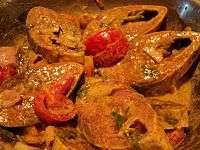
- Machha Besara: A fish curry prepared with mustard paste.[11][29]
- Machha Mahura: A curry prepared with fish and vegetables.[11][30]
- Machha Jhola
- Chingudi Jhola
- Dahi machha
- Machha chhencheda|Mudhi Ghanta
- Chunna Machha Jhola
- Chunna Machha Tarkari: Small fried fishes[12]
- Chingudi Malai Tarkari: A prawn curry[12]
- Kankada Jhola: Crab curry[12]
- Chingudi chadchadi
- Kokali sukhua rai[31]
Fritters and fries
- Alloo piaji[32]
- Bhendi baigana bhaja[12]
- Badi Chura[33]
- Pampad : flat savory snack like appetizer which looks very simillar to that of roti, usually eaten during lunch time
- Phula badi
Sajana Chhuin Bhaja
Snacks
Desserts and sweets
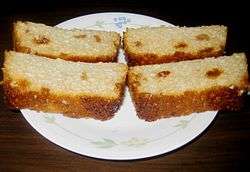
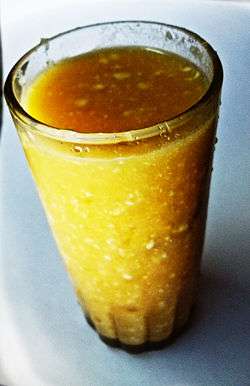
- Kheeri: Kheeri is the Odia word for kheer, predominantly made of rice.[13][36]
- Chhena Poda: A sweet made from soft cheese dipped in sugar syrup and baked. It may contain dry fruits.[2]
- Chhena Gajja[24]
- Malpua[32]
- Kora[4]
- Khira sagara[32]
- Chhena jhilii[12]
- Chhena kheeri
- Chhena Jhili[21]
- Rasagola: The sweet was invented in the 19th century by a Calcutta sweetmaker.[4][37] This is however disputed by artisans from Odisha.
- Gulab jamun[6][37]
- Rasabali[12][21]
- Rasmalei[37]
- Aadasi
- Attakali[38]
- Jalebi
- Gojja : a light savory snack
- Rabidi : a sweet curd like dish
- Mudki:A famous savory snack which looks very similar to that of a jalebi but the only difference being that jalebi are on the sweet palete where as mudki are light and in the savory side
References
- ↑ "The coastal edge". The Telegraph (India). 27 March 2010. Retrieved 11 September 2014.
- 1 2 3 4 5 6 "From the land of Jagannath". The Hindu. 28 July 2004. Retrieved 11 September 2014.
- ↑ "Not a stereotyped holiday". The Hindu. 10 March 2002. Retrieved 11 September 2014.
- 1 2 3 4 5 6 7 Charmaine O' Brien (15 December 2013). "Orissa". The Penguin Food Guide to India. Penguin Books Limited. p. 188. ISBN 978-93-5118-575-8. Retrieved 9 December 2014.
- ↑ Utsa Ray (30 November 2014). Culinary Culture in Colonial India. Cambridge University Press. p. 126. ISBN 978-1-107-04281-0.
- 1 2 3 Rocky Singh; Mayur Sharma (25 July 2014). Highway on my Plate-II: the Indian guide to roadside eating. Random House India. p. 370. ISBN 978-81-8400-642-1.
- ↑ Northeast India. Lonely Planet. 2007. p. 86. ISBN 978-1-74179-095-5. Retrieved 9 December 2014.
- ↑ "New cookery show on TV soon". The Hindu. 23 Dec 2010.
- ↑ "Inside Delhi". The Hindu. 11 January 2011. Retrieved 11 September 2014.
While savouring Chingudi malai curry (prawns with rich Oriya spices) and kukuda jhola (chicken cooked with spices and egg), the friend soaked in the atmosphere and was transported back to the sight and smell of his native place.
- ↑ "Pakhala, a hot favourite in Odisha`s summer menu". Zee News. 11 April 2010. Retrieved 9 December 2014.
- 1 2 3 4 5 6 7 8 9 "Oriya cuisine spices up syllabus". The Telegraph (India). 23 Feb 2011. Retrieved 11 September 2014.
- 1 2 3 4 5 6 7 8 9 "Yummy fare at Odia food fest". The Hindu. 26 Feb 2010. Retrieved 11 September 2014.
- 1 2 "Women vie for kitchen queen title — Contestants cook up mouth-watering dishes at cookery contest". The Telegraph (India). 9 August 2010. Retrieved 11 September 2014.
Oriya dishes like khiri, khichdi, kasha mansa were also prepared by the contestants.
- ↑ "Khechidi". Oriya Kitchen. Retrieved 9 December 2014.
- 1 2 "Potpouri" (The Telegraph (India)). 29 July 2011. Retrieved 11 September 2014.
- ↑ "Palau (pulao)". Oriya Kitchen. Retrieved 9 December 2014.
- ↑ "Kanika". Destination Orissa. Retrieved 9 December 2014.
- 1 2 "Rahul savours 'dalma' and 'khir'". The Hindu. 14 May 2008. Retrieved 11 September 2014.
- ↑ Bijoylaxmi Hota; Kabita Pattanaik (2007). Healthy Oriya Cuisine. Rupa & Company. p. 29. ISBN 978-81-291-1118-0.
- ↑ "Kadali Manja Rai". eOdisha. Retrieved 9 December 2014.
- 1 2 3 4 "Tasty treat of tangy khatta & spicy tadka". The Telegraph (India). 12 August 2010. Retrieved 11 September 2014.
The Odia thali consists of tangy khatta and proceeds further with traditional dishes such as the green and healthy spinach item saga badi.
- ↑ "कच्चे आम की रसीली चटनी: अंबा खट्टा". Boldshy (in Hindi). Retrieved 9 December 2014.
- ↑ "Recipe: Tomato-khajuri khatta". The Times of India. 1 October 2012. Retrieved 9 December 2014.
- 1 2 "It's time to pamper your tastebuds". The Telegraph (India). 16 June 2011. Retrieved 11 September 2014.
- ↑ "Coriander Chutney". FullOdisha. Retrieved 9 December 2014.
- ↑ Lokesh Dash. "Recipes Methi Saga Recipes". OrissaSpider.com.
- ↑ "Poda pithas take the cake". The Telegraph (India). 16 June 2011. Retrieved 11 September 2014.
- ↑ "Traditional 'pitha' undergoes a sea change". The Hindu. 14 April 2008. Retrieved 11 September 2014.
- ↑ "Machha Besara (A spicy dish of Rohu fish)". Five Tastes. Retrieved 9 December 2014.
- ↑ "Machha Mahura (Fish with Mixed Vegetable Curry)". Bewarchi.
- ↑ https://odiarecipes.com/details.php?htid=76
- 1 2 3 4 "Good response to Odiya food festival". The Hindu. 2 April 2012. Retrieved 11 September 2014.
- ↑ "Badi chura". Odia Recipes. Retrieved 11 September 2016.
- ↑ "Matar Ghugni aur Murmure". Mamta's Kitchen. Retrieved 9 December 2014.
- ↑ "Youths from Bihar and UP rule the 'golgappa' market". The Hindu. 13 November 2009. Retrieved 11 September 2014.
- ↑ "A cook-off in the lord's name". The Telegraph (India). 19 July 2013. Retrieved 11 September 2014.
- 1 2 3 "Several good reasons to loiter". The Hindu. Retrieved 11 September 2014.
Mouth-watering malpua, rasagulla, rasamalei, gulab jamun and other Oriya sweetmeats are served here.
- ↑ "Attakali". Odia Recipes. Retrieved 11 September 2016.
Further reading
| Wikimedia Commons has media related to Cuisine of Odisha. |
- Bijoylaxmi Hota; Kabita Pattanaik (2007). Healthy Oriya Cuisine. Rupa & Company. ISBN 978-81-291-1118-0.
- Sujata Patnaik; Ranjita Patnaik (2010). Classic Cooking of Orissa. Allied Publishers. ISBN 978-81-8424-584-4.
- Laxmi Parida (1 April 2003). Purba: Feasts from the East: Oriya Cuisine from Eastern India. iUniverse. ISBN 978-0-595-26749-1.
